
Related
Guests
- Mark Kitchelldirector of A Fierce Green Fire. His previous film, Berkeley in the Sixties, was nominated for an Academy Award.
In an Earth Day special, we look at the history of the global environmental movement as told in the sweeping new documentary, “A Fierce Green Fire: The Battle for a Living Planet.” We air extended highlights from the film — from New York housewives who take on a major chemical company that polluted their community of Love Canal to Greenpeace’s campaigns to save whales, to the fight by Chico Mendes and Brazilian rubber tappers to save the Amazon rainforest. We also speak to the film’s Oscar-nominated director, Mark Kitchell. “We were really looking to tell stories of the movement. We thought it would be a more engaging and impassioned approach to what are very difficult subjects. Usually environmental films, no matter how good they are, are an eco-bummer,” Kitchell says. “These people succeed against enormous odds. And that should give us some kind of hope.” “A Fierce Green Fire” airs tonight on PBS American Masters.
Transcript
AMY GOODMAN: Today is Earth Day. It began in 1970 as a “National Teach-In on the Crisis of the Environment” and has grown to become a worldwide day of action. Forty years ago, one in 10 Americans participated in Earth Day. This year an estimated one billion people will join in around the world.
This year’s Earth Day comes as new research published in PLOS ONE highlights the connection between pollution and racial injustice. Nationwide, people of color on average are exposed to 38 percent higher levels of outdoor nitrogen dioxide pollution than whites, a difference that amounts to an estimated 7,000 deaths per year from heart disease. Another study shows the number of major wildfires in the western United States has dramatically increased due to drought and rising temperatures from climate change. The findings published in the journal Geophysical Research Letters show the number of large wildfires rose from 1984 to 2011 at a rate of seven fires per year. Earlier this month, the United Nations Intergovernmental Panel on Climate Change warned the world has just 15 years to stave off the most devastating impacts of climate change.
Well, today, we spend the hour looking at the history of the environmental movement. It’s told in the new film A Fierce Green Fire.
ELIZABETH RETTON: I carried a child for nine months. Our little Julie was stillborn. The loss of our child may be a direct result to the chemicals. Please don’t allow this to happen to anyone else before you get them out.
JOHN ADAMS: Raw sewage was going right down the Hudson River. Air pollution was growing just as fast as new automobiles were coming out.
DOUG SCOTT: The dams in the Grand Canyon, that was going to be a fight to the death.
MARTIN LITTON: They were going to take the water out of the river. All of it.
RACHEL CARSON: To these people, apparently, the balance of nature was something that was repealed as soon as man came on the scene.
JAMES FARMER: If we do not save the environment, then whatever we do in civil right will be of no meaning, because then we will have the equality of extinction.
JOHN ADAMS: All of a sudden, people said, “Wait a second. This is not how we have to live.”
LOIS GIBBS: If I was to let the two EPA representatives come out this door, does anybody know what would happen to them?
PRESIDENT RONALD REAGAN: There is environmental extremism. I don’t think they’ll be happy until the White House looks like a bird’s nest.
REPORTER: The protesters were told not to block the trucks. They are now lying in the streets now blocking one truck.
REX WEYLER: It wasn’t just a matter of holding up signs saying “stop killing the whales.” No, Greenpeace wanted to get out there in front of the whaling boats and stop them.
STEWART BRAND: They were reinventing civilization and did not know how. And I didn’t either, but I figured we might find out.
VIJAYA NAGARAJAN: How do you hold forests in common, when every other force around you is trying to get you to privatize?
WANGARI MAATHAI: We are going to shed blood because of our land. We will. Our forefathers shed blood for our land.
BILL McKIBBEN: Americans understood what was going on and what the danger was, but still nothing happening in Washington. Not a damn thing.
SEN. JAMES INHOFE: Global warming is the greatest single hoax ever perpetrated.
STEPHEN SCHNEIDER: I don’t know. Do we have to have a hurricane take out Miami and Shanghai to have everybody wake up? If it happened next year, it might be possible to still do that. What a hell of a way to run a planet.
AMY GOODMAN: That’s the trailer for A Fierce Green Fire. Yes, today is Earth Day, and we’re looking at the history of the environmental movement as told in this sweeping documentary that airs tonight on PBS American Masters. Today we’re featuring extended excerpts from the film, including a look at one of the first battles over a toxic waste dump. It may surprise you to know that it was led by housewives, led by Lois Gibbs. We’ll also look at Greenpeace’s campaigns to save whales and baby harp seals, and later, a fight by Chico Mendes and the Brazilian rubber tappers to save the Amazon rainforest. But in San Francisco, we’re joined by the director of A Fierce Green Fire, Mark Kitchell.
Mark, welcome to Democracy Now! Talk about the scope of this film and why you decided to make A Fierce Green Fire.
MARK KITCHELL: Well, we saw that nobody had made a sort of big picture overview, a history, an exploration of the environmental movement. And that was the basic impulse. We figured, 50 years into this movement, it was time to look at the broader and deeper meanings of environmentalism and where it’s going. And, you know, I do history. And it was a great pleasure and honor and challenge taking on this history. It’s sort of the largest movement the world’s ever witnessed, but so atomized and episodic that you don’t really—it doesn’t really have a sense of, you know, its larger meaning and place and what it’s about. And that was the idea, was to take on the meaning of the movement.
AMY GOODMAN: Well, we’re going to share some of the stories of these movements. We’re going to go in A Fierce Green Fire first to that battle that was led by Lois Gibbs, who would become famous for leading housewives against some 20,000 tons of toxic waste dumped by Hooker Chemical in their community of Love Canal, a neighborhood in Niagara Falls, New York. They first learned the chemicals were seeping into their homes and water, making their children sick—they learned this in 1976. This part of the film is narrated by the actress Ashley Judd. It starts, though, with Lois Gibbs herself.
LOIS GIBBS: You are murderers! Each and every one of you in this room are murderers!
PROTESTERS: We want out! We want out! We want out! We want out!
LOIS GIBBS: When Love Canal came, it was a new segment of the movement. It wasn’t that we don’t care about the forest. It was the people focus that set us aside from the other elements that had come before us, and really the focus on if the fish are dying and if the birds are dying, then we’re going to die.
ASHLEY JUDD: Buried beneath the neighborhood were 20,000 tons of poisonous chemicals dumped in an old canal by Hooker Chemical Corporation. Reports of trouble began in 1976, but Love Canal did not explode until Michael Brown, a journalist at the Niagara Gazette, wrote articles exposing the problem. They caught the eye of Lois Gibbs.
LOIS GIBBS: I read a newspaper article, and Love Canal had 20,000 tons of chemicals buried in it, and that it was leaking into the neighborhood. And so I read this newspaper, and I said, “Oh, those poor people.” The next day, there was another article, and in that one it talked about the 99th Street Elementary School, and I was like, “Oh, my goodness. That’s where Michael’s going to kindergarten. That’s why Michael’s so sick.”
ASHLEY JUDD: Lois tried to get her son transferred to another school, but the superintendent refused.
LOIS GIBBS: When I met with Dr. Long, he said, “I am not about to move 407 children because of one irate, hysterical housewife with a sickly kid.”
ASHLEY JUDD: Instead, Lois began to circulate a petition to close the school. She went door to door, discovering the extent of the damage.
LOIS GIBBS: I was shocked. I was absolutely shocked. I thought I was the only one with a sickly child. I thought I was the only family that was affected by these leaking chemicals from Love Canal. In their basement, you could see where the chemical residue just comes up through the basement floor and just pools there. And it smells. It smells like a chemical factory. It’s nasty.
This hole just popped up, and this is what we feel is causing a lot of the birth defects and the miscarriages and health problems in the area.
MARGE BATES: In ’76—it was before Love Canal broke—I got pregnant. I carried the child for nine months. The baby weighed three pounds, and it was a stillborn birth.
LOVE CANAL RESIDENT: I’ve had two miscarriages. I had a miscarriage living in this house, and I had a miscarriage when I worked for Hooker Chemical. My god, and I almost panicked. I couldn’t believe it. Both my children were born premature.
ASHLEY JUDD: When Lois took her case to the state, officials surprised her with an emergency declaration to evacuate the nearest homes. However, the outer ring of homes surrounding Love Canal—800 families—were given nothing.
LOVE CANAL RESIDENT: Would you please tell me: Do I let my three-year-old stay? She has a birth defect now.
LOVE CANAL RESIDENT: What are you going to do for my kid? What are you going to do? Nothing. Think the damage is done, man. The damage is done.
ASHLEY JUDD: The state bought the inner ring of houses. Then they put up a fence and began to excavate. Love Canal residents outside the fence felt trapped.
INTERVIEWER: When did the state tell you to stop growing your vegetable garden?
GRACE McGOULF: In August of ’78.
INTERVIEWER: So they weren’t willing to move you out, but they were willing to tell you to stop growing vegetables?
GRACE McGOULF: Yeah, willing to tell us not to have the kids go barefooted, not to have them go in the basement, don’t plant a garden, but enjoy your house. Live there with your family, while we continue doing our tests and use you as guinea pigs.
ASHLEY JUDD: The Love Canal residents decided to do their own health study and found an alarming increase in disease and birth defects.
LOIS GIBBS: We truly believed, if we can prove that there was an increase in disease, they, meaning the government, will do the right thing. And we found that 56 percent of the children in our community were born with birth defects. Fifty-six percent of our children had three ears, double rows of teeth, extra fingers, extra toes or were mentally retarded. During that study time, there were 22 women who were pregnant, and of those 22 pregnancies, only four normal babies were born. And the Health Department literally threw the health study on the floor—I mean, literally, took it and just threw it on the floor and said, “It’s useless housewife data collected by people who have a vested interest in the outcome.”
ASHLEY JUDD: The New York State Health Department was prodded into doing its own health study and presented their findings to a packed meeting in Love Canal.
LOIS GIBBS: The health commissioner took the stage and said, “We found that 56 percent of the children in Love Canal were born with birth defects.” And we’re secretly, as sick as it sounds, saying, “Yes, yes! And now you’re going to evacuate us, right?” I mean, that’s what we’re hoping for. And then he says, “But we don’t believe those birth defects are related to Love Canal.” And it’s—just the whole audience, you could hear was: “Huh?” I mean, it was just like—and it’s like, “We believe that those birth defects are related to a random clustering of genetically defected people.”
ASHLEY JUDD: For the residents, Love Canal became a two-year struggle to get relocated. Lois Gibbs pushed relentlessly and finally forced the state to bring in the federal government. The Environment Protection Agency launched a pilot study of chromosome damage. The results of the tests were explosive.
LOIS GIBBS: Chromosome damage means my two children may be genetically damaged as a result of Love Canal. That was the straw that broke the camel’s back.
EPA REPRESENTATIVE: We’ll then decide whether this evidence, added to the cumulative knowledge that we already have from other health and environment studies at Love Canal, justifies a recommendation for relocation of the residents or other appropriate actions to assist those in the area.
LOVE CANAL RESIDENT: It seems to me that the federal government has finally, after two years, come up to the high-level thinking of housewives that they have constantly put down. We know what’s going on. We did research, too. And we want out of there. We want our kids out. Not on Wednesday. Today.
ASHLEY JUDD: The EPA recommended relocation, but the White House blocked the emergency declaration. The residents of Love Canal demanded an explanation. When EPA officials arrived, they decided to take them hostage.
LOIS GIBBS: Just pass the word around. Nobody—we’re not going to do anything violent. We’re just going to keep them in the house. Nothing more than that, body-barricade the doors. OK?
PROTESTER: OK.
LOIS GIBBS: Pass the word. And don’t let them out.
PROTESTER: No one’s coming out.
PROTESTER: Come on, guys! Sit.
LOIS GIBBS: If I was to let the two EPA representatives come out this door, does anybody know what would happen to them?
PROTESTER: We’d tear them apart!
FRANK NEPAL: I guess I’m here for the duration.
REPORTER: Meaning what, the duration?
FRANK NEPAL: Well, I guess until the White House gives the homeowners some sort of answer.
LOIS GIBBS: Well, I call up the White House. The lady started giving me this lecture about how Love Canal residents have blown it out of proportion and lots of people die of cancer, and we should just—I’m like, “You know, lady, if I was a crazy, I’d kill these hostages.” And I hung up the phone. I’m thinking, like, I am crazy.
REPORTER: Homeowners association president Lois Gibbs spoke with Congressman John LaFalce in Washington to try to get some answers. LaFalce is set to meet with President Carter at this hour at a dinner meeting at the White House. We should have more information…
LOIS GIBBS: I went out on the front porch and said, “OK, guys, the president hears us. He’s going to hear from our congressman. I think we should let them go, and I think we should let them go with a very strong warning.”
I have told the White House—and this is upon your approval—that we will allow the two EPA representatives to leave, but if we do not have a disaster declaration Wednesday by noon, then what they have seen here today is just a Sesame Street picnic in comparison.
ASHLEY JUDD: Two days later, Lois called the White House. Amazingly enough, her ultimatum worked.
LOIS GIBBS: An emergency to permit the federal government and the state of New York to undertake…
And then, all of a sudden, she said, “And we will grant temporary relocation.” I’m like, “And we will grant temporary relocation”—all of a sudden it was just like even the birds, I swear, weren’t singing—”until we can get permanent relocation money allocated, but permanent relocation is the goal.”
DEBBIE CERILLO: Here’s to the homeowners and all their hard work, huh?
ASHLEY JUDD: At last, President Carter came to Love Canal to sign the agreement buying out the homeowners.
PRESIDENT JIMMY CARTER: The whole question of a disposal of hazardous waste, especially toxic chemicals, is going to be one of the great environmental challenges of the 1980s. There must never be in our country another Love Canal. Thank you very much.
AMY GOODMAN: Yes, that was President Jimmy Carter and, throughout the excerpt, Lois Gibbs and others who led the struggle to take on Hooker Chemical in Love Canal, a community in Niagara Falls, New York. The story is told in A Fierce Green Fire, a film that tells the history of the environmental movement through these different struggles. In this Earth Day special, when we come back, we’ll look at Greenpeace and its battle to save the whales, as well as Chico Mendes and the rubber tappers of Brazil fighting to save the Amazon. Stay with us.
[break]
AMY GOODMAN: This is Democracy Now!, democracynow.org, The War and Peace Report. I’m Amy Goodman. Yes, today is Earth Day, and we’re looking at key moments in the history of the environmental movement as told in the new film A Fierce Green Fire, directed by Mark Kitchell. It’s airing tonight on PBS American Masters. As we turn now to another extended excerpt about a ragtag group of ecologists who helped launch the group Greenpeace—their first campaign, a fight to save the whales. In this excerpt, we bring you Greenpeace co-founders Rex Weyler, Paul Watson and Bob Hunter. It’s narrated by Van Jones, President Obama’s former green jobs czar.
VAN JONES: In 1975, Greenpeace set off to hunt the whalers. After two months at sea, they came upon the Russian whaling fleet.
REX WEYLER: There’s five over there. There’s on by the Vostok, and there’s three over here. There’s nine chasers altogether.
We’re coming upon a floating slaughterhouse. There’s blood in the water. There’s huge slabs of blubber being hauled up on these big factory ships. Blood is just pouring out of this pipe. And the stench alone made us all want to throw up.
PAUL WATSON: Suddenly, Bob and I were in a small boat in front of a Soviet harpoon vessel that was bearing down on us. In front of us is eight magnificent sperm whales that were fleeing for their life. And every time the harpooner tried to get a shot, I was at the helm so I would maneuver the boat to try and block the harpoon.
REX WEYLER: Here’s the whales. Here’s us in our Zodiacs. And here’s the Russian ship. We are right between the Soviet ship and the whales. And the harpooner’s not shooting, but eventually somebody from the bridge walks down the catwalk and talks to the harpooner, and the harpooner nods, and the guy goes back. And Bob looks in his eyes, and he knows: This guy’s going to shoot this harpoon.
PAUL WATSON: The he looked at us and smiled and brought his finger across his neck. And that’s when I realized Gandhi wasn’t going to pull through for us that day.
REX WEYLER: And at that very moment, they fire the harpoon.
PAUL WATSON: This harpoon flew over our head and slammed into the backside of one of the whales. And she screamed. It was a very human-like screen, like a woman. And it took us completely off guard.
REX WEYLER: The whalers purposefully shoot at the female first, because they know that the bull whales will attack them. And then, when the bull whales come to attack them, which is exactly what happened…
PAUL WATSON: He was waiting for them and very nonchalantly pulled the trigger and sent a second harpoon into the head of the whale. And he screamed and fell back. And now the water’s full of blood everywhere from the two dying whales. And as this whale lay and, you know, rolled in agony on the surface of the ocean, I caught his eye, and he looked straight at me.
REX WEYLER: And we’re looking into the eye of this huge sperm whale. And I have to tell you, it—it’s sort of beyond emotional. You know, when you—there are certain moments that are so emotional, you’re just in brand new territory.
PAUL WATSON: Why were the Russians killing these whales? You know, they didn’t eat sperm whale meat, but they did use the spermaceti oil to make high-heat-resistant lubricating oil for machinery. And one of the pieces of machinery that they used it in is the manufacture of intercontinental ballistic missiles. And I said, “Here we are destroying this incredibly beautiful, intelligent, socially complex creature for the purpose of making a weapon meant for the mass destruction of humanity.” And that’s when I—it came to me with a—you know, like a flash, that we’re insane. We’re just totally insane. And from that moment on, I decided that I work for whales, I work for seals, I work for sea turtles and fish and seabirds. I don’t work for people.
REX WEYLER: The story just exploded. And I think it was because people were seen, for the first time, not just standing up for the dispossessed humans, standing up for the dispossessed everything else in the world, every other species in the world that has been dispossessed by the industrial civilization of humankind.
VAN JONES: Greenpeace’s new style of media-oriented activism launched them into the wildest ride of any environmental group.
REX WEYLER: We were out there trying to make the whales famous, but in the process we made ourselves famous. We were now able to talk about ecology, and we were able to raise money. Now we were able to do a seal campaign and a toxic dumping campaign. Offices were springing up all over the world calling themselves Greenpeace.
VAN JONES: Their critics claimed that they were better at dramatizing issues than effecting change. But Greenpeace saw the media as the best means of changing consciousness. They called it dropping mind bombs.
BOB HUNTER: My idea was that if you took an image and you passed it through the media into the mass mind, you could essentially blow the mass mind with new images that would create whole new ways of looking at the world. And the image of small whales up against giant whaling machines was a mind bomb.
VAN JONES: In 1976, Greenpeace dreamed up their next campaign: to save baby harp seals in Newfoundland.
REX WEYLER: We used the same tactics that we used with the whaling campaigns: We actually got out on the ice, blockaded the sealing ships.
BOB HUNTER: We’re blocking the boat.
PAUL WATSON: He’s backed out three times and came forward already, trying to bluff us off.
BOB HUNTER: No, he might just be lining up for a big one soon.
VAN JONES: The first year, they ran into furious opposition, especially over Paul’s plan to spray dye on the seal pups, rendering the pelts worthless.
PAUL WATSON: That’s, I think, where I had a first falling out with Bob, really, because they compromised with the Newfoundlanders, you know, and said, “Well, we’re not going to dye the seals if you don’t do this.” And I got real—you know, they didn’t consult with me on it, so I was quite angry on it. I don’t believe in compromising.
VAN JONES: Paul was bitter. He came back the next year determined to stop the slaughter.
PAUL WATSON: On the second seal campaign in '77, you know, I pulled a sealing club out of a sealer's hand, threw it in the water. I handcuffed myself to the pile of pelts to try and shut down their operations. They pulled the pelts into the water and pulled me through the water and up the side of the boat and dangled me from the air, and then they dropped me back in the water. And then they brought me up on the deck, and then they pulled me along the deck as these sealers were spitting and kicking and punching. Captain came in and started screaming at me about how, you know, it was people like me that ended whaling and, you know, “Now you’re trying to take sealing away from us.”
VAN JONES: Soon after the second seal campaign, Paul Watson was thrown out of Greenpeace for breaching their ethic of nonviolence. He had gone too far. Paul vowed to pursue the whalers without compromise. He set up his own group, the Sea Shepherd Society, and got himself a ship. The first thing he did was hunt down the Sierra, an illegal pirate whaler. Off the coast of Portugal, he found her.
PAUL WATSON: I hit the Sierra at the bow to get its attention and to destroy the harpoon, then did a 360-degree turn around its stern and slammed into its side at 15 knots and split it open to the water line. That ship had killed 25,000 whales. What we are able to do in one year was to shut down every single pirate whaling vessel in the Atlantic. At the end of that one-year period, three of them were on the bottom, two of them were going to be sunk by the South African navy, and one of them had been sold.
VAN JONES: Then Sea Shepherd went after whaling nations, scuttling Spanish, Norwegian and Icelandic whalers.
PAUL WATSON: In 1986, when we sank half of Iceland’s whaling fleet, John Frizell from Greenpeace came up to me. He said, “Just want to let you know that what you did in Iceland was despicable, reprehensible, criminal and unforgivable.” And I said, “So?” And he said, “Well, you should know what people in this movement think about you.” I says, “I don’t give a damn, John. I didn’t sink those whaling vessels for you or anybody in the movement. We sank those whaling vessels for the whales. Find me one whale that disagreed with what we did, and we’ll reconsider. But until then, I couldn’t give a damn what you people think.”
VAN JONES: It took everyone working together to ban whaling. For 10 years, radicals and mainstream, governments and NGOs campaigned to turn the International Whaling Commission from hunting to saving whales.
BOY: Why should we kill them if they’re just—it’s just like killing us?
GIRL: But they’re just nice creatures. They’re nice. They wouldn’t harm anyone, really.
INTERNATIONAL WHALING COMMISSION DELEGATE: What we are proposing is a moratorium.
VAN JONES: A moratorium finally passed in 1982. And in time, it became a permanent ban on whaling, one of environmentalism’s biggest successes.
AMY GOODMAN: That was Van Jones narrating an excerpt of the film A Fierce Green Fire, which tells the history of the environmental movement for more than the past half-century and airs tonight on PBS American Masters. We’re joined by its director, Mark Kitchell. Mark, that story, the Greenpeace chapter, if you will, is one of five in this film, which you call A Fierce Green Fire. Why?
MARK KITCHELL: Oh, there’s a famous story. It happened about a century ago in—a young ranger named Aldo Leopold, whose job was to kill predators, he shot a wolf. And he went down the hill to see a fierce green fire in her eyes as she was dying. And that was his awakening. And he wrote a famous essay about it called “Thinking Like a Mountain.” But for us, we think of a fierce green fire as the movement, the environmental movement, and that’s the way we use it in the film. And that’s what we were really trying to do in this film that makes it different from other environmental films that are more issue-driven. We were really looking to tell stories of the movement, and we thought it would be a more engaging and impassioned approach to what are very difficult subjects. You know, usually, environmental films, no matter how good they are, are an eco-bummer. It’s always about a problem and a crisis, and ends with a plea for help. In this, we thought people could really identify with people like Lois Gibbs and Paul Watson and really get the passion. And these people succeeded against enormous odds, and that should give us some kind of hope that we can deal with such overwhelming problems like climate change and the sixth great extinction and trying to create a sustainable revolution to save human society.
AMY GOODMAN: We’re going to break and then come back to another of the chapters of this film about the remarkable rubber tapper Chico Mendes and his fight in the Brazilian rainforest to save the Amazon. Mark Kitchell is the director of A Fierce Green Fire. We’ll be back in a moment.
[break]
AMY GOODMAN: Yes, today is Earth Day, and we’re looking at the history of the environmental movement as told in a new film by Mark Kitchell that airs tonight across the country on PBS. It’s called A Fierce Green Fire. This final extended excerpt looks at a turning point in the fight to save the Amazon rainforest. It is a campaign led by Chico Mendes and the rubber tappers who are fighting to save their rubber trees from loggers. Chico Mendes wins, but is assassinated. The clip is narrated by the Chilean novelist Isabel Allende. It includes comments from Barbara Bramble of the National Wildlife Federation; José Lutzenberger, a Brazilian environmentalist; and Senator Robert Kasten. But first, Chico Mendes himself.
ADRIAN COWELL: [translated] Have you always been a seringueiro?
CHICO MENDES: [translated] Always. My father was a seringueiro. I started at nine years old, and for 20 years I was a full-time seringueiro. It was only in 1975, when the ranchers arrived, that I joined the union and cut less rubber.
ISABEL ALLENDE: The rubber tappers, known as seringueiros, squatted off the old seringals, or plantations, produced rubber and subsisted off the land. They were protected by being in the remote western Amazon, where roads had not penetrated. But as ranchers arrived and began clearing the land to claim it for tax breaks, Chico Mendes organized the rubber tappers to defend their territory.
CHICO MENDES: [translated] The ranchers’ aim was to take all this land. But we won’t let them have it. We’ll fight to the end. We won’t allow our forests to be destroyed.
ISABEL ALLENDE: The rubber tappers organized empates, or standoffs, nonviolent protests in the tradition of Gandhi and Martin Luther King, where they surrounded the trees and tried to explain what a disaster cutting down the forest was for everyone.
RAIMUNDO DE BARROS: [translated] Comrade, come here. Don’t be nervous.
CREW CHIEF: [translated] I’m not frightened.
RAIMUNDO DE BARROS: [translated] Of course not. You’re a worker like us. The ranchers’ aim is to get everything. Once they destroy this natural wealth, which belongs to seringueiros, as well as you and all workers, it’s wonderful for them, because everywhere will be fenced and full of cattle. Then how will we live?
CHICO MENDES: [translated] You’re not ranch gunmen, but workers earning money.
BARBARA BRAMBLE: They actually were able to stop the forest cutting by standing in front of the trees. It’s a real heroic story. And it happened often enough that it actually impeded an entire cattle-ranching operation so much that they gave up.
CHICO MENDES: [translated] There are other landowners. But for the first time, we’ve won a victory against the Bordon group, the most powerful of the region. We’ve succeeded in defending most of a seringueiro’s territory.
ISABEL ALLENDE: American environmentalists helped bring Chico Mendes to the United States to campaign against the World Bank, whose loans led to destructive development.
JOSÉ LUTZENBERGER: The World Bank wants us to believe that they are helping the people in those areas. Now, this is a big lie and an infamous lie. The opposite is true: The people living in the forests, they have an interest in their preservation.
PROTESTERS: Save the rainforest! Save the rainforest! Save the rainforest! Save the rainforest!
CHICO MENDES: [translated] I hope that the governments which give money to the IDB, the people of the U.S., England, Japan, Europe, who contribute their taxes to finance the IDB, will listen to the seringueiros’ complaints.
SEN. ROBERT KASTEN: Our subcommittee is going to continue to put pressure on the IDB to withhold funds, to cut off all funds, possibly, if they are not more cooperative.
ELECTIONEERING CAR IN RIO BRANCO: [translated] Chico Mendes, in defense of the Amazon forest, against the devastation of the jungle and expulsion of its people, for the creation of extractive reserves.
ISABEL ALLENDE: Chico was coming to understand that saving their way of life meant saving the Amazon. He began to build alliances with other rubber tappers and indigenous groups.
BARBARA BRAMBLE: Several leaders and Chico decided to hold a meeting to try to form a national council of rubber tappers. What they all came to the conclusion of was that they needed to have rights to use the land, that one of the things that was keeping them from being able to effectively defend the forest against the chainsaw loggers and the cattle ranchers was not having an actual right to this land. They were seen as squatters.
ADRIAN COWELL: The idea was raised that there should be rubber tapper reserves, like Indian reserves. The people wouldn’t own the land, but it would be theirs for as long as they wanted to work it. It was an idea of the people who actually lived in the forest. That was a huge breakthrough in concept. This is a great movement within Amazonia, and that’s what Chico started.
ISABEL ALLENDE: The rubber tappers decided to establish the first reserve at Cachoeira, the old rubber plantation where Chico was born and lived with family and friends. However, the land had been bought by a rancher named Darli Alves, so the seringueros went to court to claim their squatter rights. It turned into a showdown.
DARLI ALVES: [translated] Xapuri ranchers have always had trouble with seringueiros blocking their deforestation. Every time the ranchers tried to deforest, they were blocked. In Xapuri, it’s stalemate.
CHICO MENDES: [translated] We are in immediate danger. We’re seeing people killed. And there could be many more. The Parana ranch is terrorizing the whole population of Xapuri to strike at me, at Comercindo, at Haymundabajos, and the whole directorate of our workers’ movement.
Even though we want this to be peaceful, it may come to the point where the peaceful side won’t work, and we can’t be demoralized. We will go to the confrontation knowing someone may lose his life. Will you be with me?
ISABEL ALLENDE: The rubber tappers won. Cachoeira was declared the first extractive reserve in the world. It was an important victory to the whole of the Amazon. But the rancher Darli Alves had vowed to kill Chico Mendes.
FRIAR LUIS CIPPI: [translated] This has not been a bloodless journey. Some have already fallen defending extractive reserves. No one likes to die. But if it has to happen, then it should be to create more life. Christ was crucified. He gave his last drop of blood. But since that day, millions of communities have been born that believe and fight for brotherhood.
RUBBER TAPPERS: [translated] I promise, before the blood of our companion Chico Mendes, to continue his work, to show our enemies that they will never succeed in silencing the voice of the seringueiros. Chico Mendes, wherever you are, don’t grieve that they have silenced your voice. Your ideas exist among us.
BARBARA BRAMBLE: There were things that came together after his death that probably couldn’t have come together if he was still alive, because they’d still be fighting over whether the extractive reserves should be established or not. After he was killed, there was no question. So now it’s quite clear that who saves forests are the people in the forest.
PROTESTERS: Lula president! Chico Mendes is with us! Lula president! Chico Mendes is with us!
ISABEL ALLENDE: Chico Mendes’ work proved to be the turning point in the battle to save the Amazon. The Brazilian government recognized the rights of the forest peoples and established an array of parks and protected areas. Fifty-eight million acres were set aside in extractive reserves. Forty percent of the Brazilian Amazon was formally protected. However, the fate of the forest is still in doubt. Now it is not just cattle ranchers, but soy farming on an industrial scale and illegal logging. Due to the partial deforestation and the climate changes it has brought, the Amazon is drying out.
AMY GOODMAN: That excerpt narrated by the Chilean novelist Isabel Allende. It is from A Fierce Green Fire, a film that premiered at the Sundance Film Festival and will air tonight on PBS. Yes, today is Earth Day. The film looks at the environmental movement over more than the last half-century, and it’s directed by Mark Kitchell, who we end with today. Mark, talk about your choices. These chapters in the film—on Greenpeace, on the rubber tappers and Chico Mendes, on Love Canal—talk about the final chapter and then how you chose these as emblematic of the environmental movement.
MARK KITCHELL: Well, the final act is climate change, the mother of all environmental issues, so big that it overwhelms everything else. And we tell that 25-year struggle to deal with it, the largest problem that the world’s ever faced. It’s largely a tale of frustration. Bill McKibben talks about the inability of the movement to deal with the issue for most of the ’90s. We go on from Copenhagen and sort of explore bottom-up movements versus top-down political failure, and really try and make the point that we need the bottom-up, the grassroots, pressure to force change from the top.
And Paul Hawken, with his brilliant ideas from Blessed Unrest, talks about how there’s probably two million groups worldwide working on these issues of environmental justice and the environment and indigenous rights and how they’re all connected. And he uses a metaphor of the movement being humanity’s immune response system. And I just think that’s a brilliant way to characterize a movement. It’s sort of a movement like we’ve never seen before in this world.
And it’s headed for bigger things. And, you know, we wanted to do an act six. We wanted to take on the future, and we tried various endings, and we could never fit it in. We had to get the film over. And so we just decided that we’ve got to do A Fierce Green Future, another film, and really take on that sustainable revolution, if you will.
I think ultimately this is about civilizational transformation. It’s going to be as big a change as the Industrial Revolution. And the task before us is to create a society that’s sort of moving from our industrial basis to a world in which we’re in sustainable balance with the natural world. I think that’s the only way we can survive. And I think this is just the first 50 years of it.
AMY GOODMAN: Mark Kitchell, I want to thank you for being with us, director of A Fierce Green Fire, which airs on PBS American Masters tonight at 9:00 p.m. Eastern, tonight, on this day, Earth Day. You can visit our website for a link to local listings. Today is Earth Day. And you can tell us how you’re involved, if you are, with the environmental movement, who inspires you. Go to our Facebook page, and on Twitter, you can use the hashtag #discussDN.

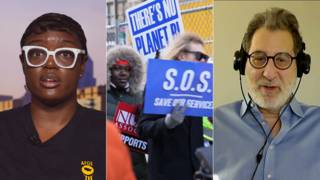
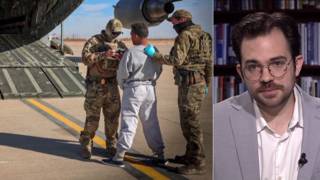
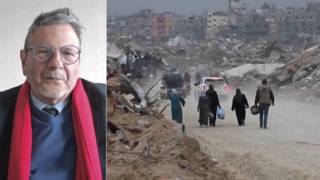
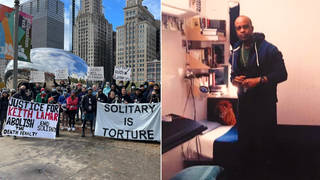

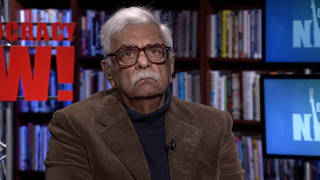
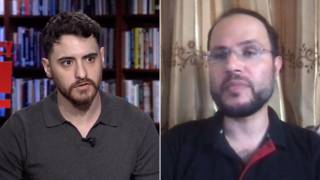

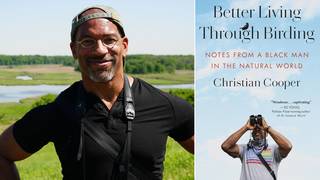
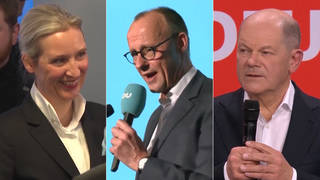
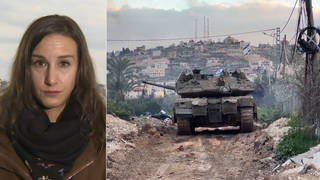
Media Options